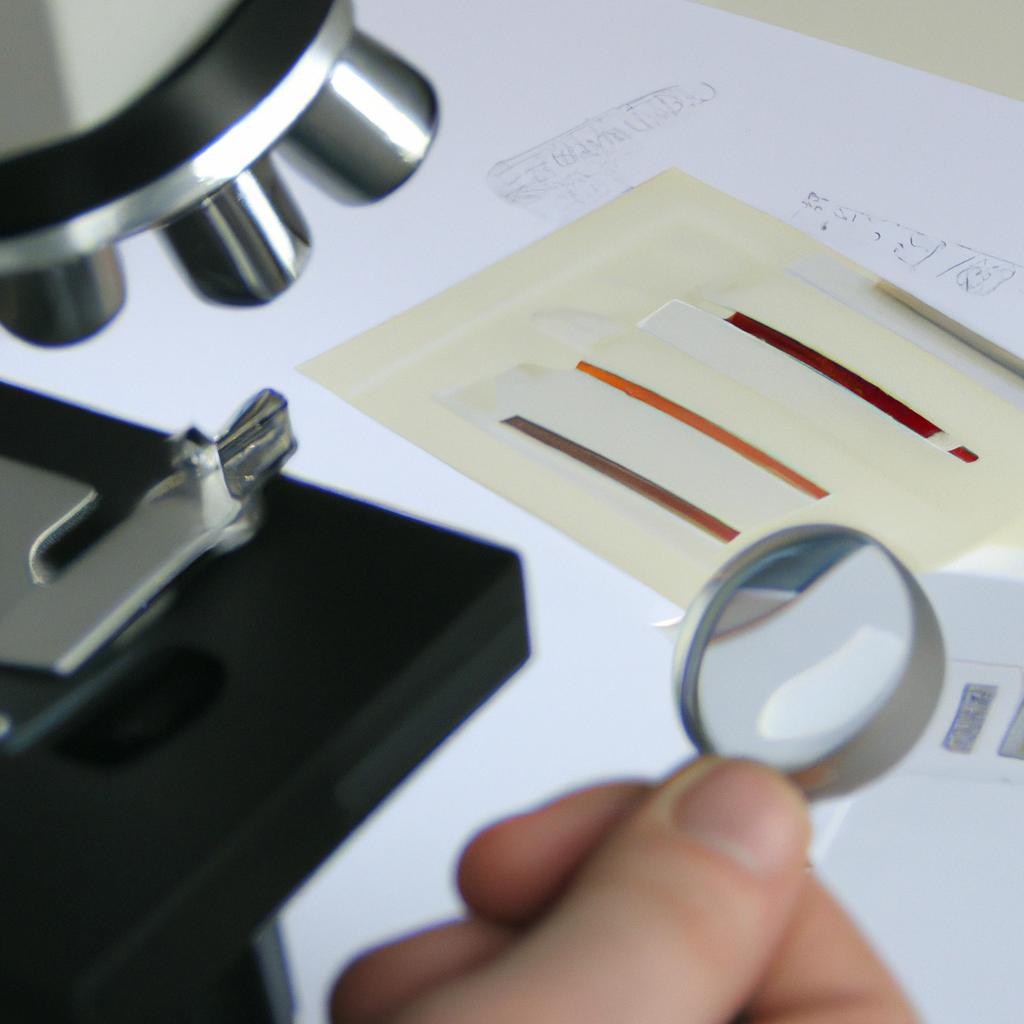Hematopoietic disorders encompass a wide range of conditions that affect the production, maturation, and function of blood cells in veterinary medicine. These disorders can manifest as abnormalities in cellular morphology, leading to significant diagnostic challenges for clinicians and pathologists. Understanding the intricacies of hematopoiesis and recognizing characteristic morphological changes are crucial for accurate diagnosis and effective management of these disorders.
Consider the case of a 6-year-old German Shepherd presenting with lethargy, anemia, and bleeding tendencies. Upon examination of a peripheral blood smear, the veterinarian noticed abnormal red blood cell morphology characterized by irregular shapes, fragmented cells, and increased numbers of nucleated red blood cells (NRBCs). This observation raised suspicions of a hematopoietic disorder affecting erythropoiesis. To confirm the diagnosis and determine appropriate treatment options, further investigations were necessary to evaluate other aspects of cellular morphology such as white blood cell distribution, platelet counts, and bone marrow evaluation.
In this article, we will delve into the field of veterinary clinical pathology with a specific focus on hematopoietic disorders. By examining various examples and discussing key principles related to cellular morphology assessment in different types of hematopoietic disorders encountered in veterinary practice, we aim to provide a comprehensive understanding of the diagnostic approaches and management strategies for these conditions.
Overview of Hematopoiesis
Hematopoiesis, the process by which blood cells are formed and developed, plays a crucial role in maintaining homeostasis within an organism. This intricate process occurs primarily within the bone marrow, where hematopoietic stem cells undergo differentiation to form various types of mature blood cells. To illustrate this concept, consider the case of a feline patient presenting with chronic anemia. Through careful examination of the bone marrow sample obtained from this cat, veterinary clinicians were able to gain insights into abnormalities within the hematopoietic system.
Understanding hematopoiesis is essential for diagnosing and managing hematologic disorders in veterinary medicine. The process can be broadly categorized into two phases: proliferation and maturation. During proliferation, hematopoietic stem cells divide and differentiate into progenitor cells specific to each blood cell lineage (e.g., erythrocyte, leukocyte). These progenitors then enter the maturation phase wherein they acquire specialized functional properties through sequential steps of development.
To emphasize the significance of proper hematopoiesis regulation, here is a bullet point list outlining some potential consequences when this delicate balance is disrupted:
- Abnormalities in red blood cell production may lead to anemia or polycythemia.
- Dysregulated white blood cell production can result in leukopenia or leukocytosis.
- Impaired platelet formation may cause thrombocytopenia or thrombocytosis.
- Disruptions in any aspect of hematopoiesis can potentially give rise to malignancies such as leukemia or lymphoma.
Furthermore, a table provides a visual representation of diverse factors that influence hematopoiesis:
| Factors Influencing Hematopoiesis | Examples |
|---|---|
| Cytokines | Interleukins |
| Growth factors | Erythropoietin, granulocyte-colony stimulating factor |
| Hormones | Thyroid-stimulating hormone |
| Environmental cues | Hypoxia |
In summary, understanding the complex process of hematopoiesis is crucial for comprehending and diagnosing hematologic disorders in veterinary clinical pathology. By examining bone marrow samples and evaluating various factors that influence hematopoiesis, clinicians can gain valuable information about aberrations within this system. This knowledge serves as a foundation for further exploration into the classification of hematopoietic disorders.
Transitioning to the subsequent section on “Classification of Hematopoietic Disorders,” it becomes evident that an appreciation of hematopoiesis intricacies provides a solid groundwork for identifying and managing these disorders effectively.
Classification of Hematopoietic Disorders
Hematopoietic disorders encompass a wide range of conditions that affect the production, function, or survival of blood cells in animals. Understanding the cellular morphology associated with these disorders is crucial for accurate diagnosis and effective treatment. Building upon the previous section’s discussion on hematopoiesis, this section will delve into the classification of hematopoietic disorders.
To illustrate the significance of studying cellular morphology in veterinary clinical pathology, let us consider a hypothetical case study involving an adult dog presenting with lethargy, pale mucous membranes, and generalized weakness. On microscopic examination of a peripheral blood smear, numerous abnormal red blood cells (RBCs) exhibiting fragmented shapes are observed. This observation suggests the presence of a disorder known as hemolytic anemia, where RBC destruction occurs prematurely within circulation.
Classification of hematopoietic disorders involves categorizing them based on various criteria such as etiology, affected cell lineages, and pathophysiological mechanisms. Here are some key types:
- Anemias: Characterized by decreased oxygen-carrying capacity due to reduced RBC numbers or abnormalities in their structure or function.
- Leukemias: Neoplastic proliferations affecting white blood cells (WBCs) or their precursors.
- Lymphomas: Malignant tumors originating from lymphoid tissues and causing dysregulation of lymphocyte populations.
- Myeloproliferative Disorders: Conditions characterized by excessive proliferation of one or more myeloid cell lines.
Understanding the classification allows for tailored treatment strategies and prognostication based on specific disease characteristics. The diagnostic process typically employs several techniques including physical examinations, complete blood counts (CBC), bone marrow aspirates/biopsies, cytological evaluations, flow cytometry analysis, immunohistochemistry staining, and molecular testing.
As we transition to discussing diagnostic techniques for hematopoietic disorders in the subsequent section, it is important to recognize the importance of accurate classification in guiding appropriate diagnostic approaches. By elucidating the cellular morphology and understanding the underlying mechanisms, veterinarians can make informed decisions regarding treatment options and prognosis for animals affected by hematopoietic disorders.
Diagnostic Techniques for Hematopoietic Disorders
Classification of Hematopoietic Disorders provides a foundation for understanding the diverse range of conditions that can affect the hematopoietic system in veterinary medicine. By categorizing these disorders based on their underlying pathophysiology, clinicians can better diagnose and manage them. Now, we will delve into the diagnostic techniques used to identify and characterize these disorders.
One example of a hematopoietic disorder is myelodysplastic syndrome (MDS), a group of clonal stem cell disorders characterized by ineffective hematopoiesis and dysplasia in one or more cell lineages. In MDS, bone marrow examination plays a crucial role in diagnosis. The cellular morphology observed under microscopy reveals abnormal features such as nuclear changes, cytoplasmic abnormalities, and dyserythropoiesis. These findings aid in distinguishing MDS from other similar conditions.
To further investigate hematopoietic disorders, several diagnostic techniques are employed:
- Flow cytometry: This technique utilizes fluorescently labeled antibodies to analyze surface markers expressed by different cell populations. It allows for detailed immunophenotyping of cells involved in various hematologic diseases.
- Cytogenetics: Chromosomal abnormalities are often associated with hematopoietic disorders. Cytogenetic analysis involves examining metaphase chromosomes to detect structural alterations or numerical aberrations.
- Polymerase chain reaction (PCR): PCR amplifies specific DNA sequences and has proven valuable in detecting genetic mutations associated with certain hematologic malignancies.
- Next-generation sequencing (NGS): NGS enables comprehensive genomic profiling to identify gene mutations, rearrangements, or other molecular alterations implicated in hematologic diseases.
The significance of accurate diagnosis cannot be overstated, as it guides appropriate treatment decisions and prognosis estimation for affected animals. To illustrate this point visually, consider the following table showcasing common hematopoietic disorders in veterinary medicine:
| Disorder | Clinical Features | Diagnostic Tests |
|---|---|---|
| Immune-mediated hemolytic anemia (IMHA) | Hemolysis, regenerative anemia, autoantibodies | Coombs test, reticulocyte count |
| Thrombocytopenia | Bleeding tendencies | Platelet count, bone marrow examination |
| Lymphoma | Enlarged lymph nodes, organ infiltration | Fine-needle aspiration cytology, flow cytometry |
| Acute myeloid leukemia | Leukocytosis with blast cells | Bone marrow aspirate and biopsy |
In conclusion to this section on diagnostic techniques for hematopoietic disorders, it is evident that a comprehensive approach combining clinical evaluation and laboratory investigations is crucial. Accurate identification of these conditions enables appropriate treatment strategies and improves the overall prognosis for affected animals.
Transitioning into the subsequent section about “Common Hematopoietic Disorders in Veterinary Medicine,” we will now explore specific examples of such disorders encountered in veterinary practice. Understanding their etiology, clinical signs, and diagnostic approaches will further enhance our ability to provide timely intervention and management strategies.
Common Hematopoietic Disorders in Veterinary Medicine
Diagnostic Techniques for Hematopoietic Disorders
In the previous section, we discussed the various diagnostic techniques used to identify hematopoietic disorders in veterinary medicine. Now, let’s delve into an important aspect of diagnosing these disorders – cellular morphology.
To illustrate the significance of cellular morphology analysis, consider a hypothetical case study involving a dog presenting with lethargy and pale mucous membranes. A blood smear examination revealed abnormal red blood cell (RBC) morphology characterized by macrocytosis and polychromasia. This finding suggests possible regenerative anemia due to increased RBC production by the bone marrow.
The assessment of cellular morphology can provide valuable insights into the underlying hematologic disorder. By examining different features of cells, such as shape, size, color, and distribution within a sample, veterinary pathologists can determine if abnormalities are present and gain further understanding about the nature of the disease.
Importance of Cellular Morphology Analysis
Cellular morphology analysis plays a crucial role in identifying and characterizing hematopoietic disorders. Here are some key reasons why this technique is invaluable:
- Early detection: Abnormalities in cellular morphology can indicate early stages or subclinical forms of diseases before more severe clinical signs manifest.
- Disease differentiation: The evaluation of specific morphological changes helps distinguish between different types of hematologic disorders.
- Prognostic value: Certain morphological features may serve as prognostic indicators, aiding veterinarians in determining treatment plans and predicting patient outcomes.
- Monitoring therapeutic response: Regular monitoring of cellular morphology enables clinicians to assess how well patients respond to treatments over time.
| Early Detection | Disease Differentiation | Prognostic Value | |
|---|---|---|---|
| Benefits | – Enables prompt intervention – Improves patient outcomes | – Facilitates accurate diagnosis – Guides appropriate treatment strategies | – Helps predict disease progression and prognosis |
Common Hematopoietic Disorders in Veterinary Medicine
Now that we understand the significance of cellular morphology analysis, let’s explore some common hematopoietic disorders encountered in veterinary medicine. These disorders encompass a range of conditions affecting various components of the blood, including red blood cells, white blood cells, and platelets.
- Anemia: A decrease in RBC count or hemoglobin concentration.
- Leukemia: Abnormal proliferation of neoplastic white blood cells.
- Thrombocytopenia: Low platelet count leading to impaired clotting function.
- Lymphoma: Malignant growth of lymphoid tissue resulting in abnormal lymphocytes.
By examining the cellular morphology associated with these disorders, veterinarians can accurately diagnose and manage them effectively.
In the upcoming section on “Treatment and Management of Hematopoietic Disorders,” we will discuss various therapeutic approaches used to address these conditions and improve patient outcomes.
Treatment and Management of Hematopoietic Disorders
Hematopoietic Disorders in Veterinary Clinical Pathology: Cellular Morphology
Common Hematopoietic Disorders in Veterinary Medicine have been extensively explored, shedding light on the various conditions that can affect animals. Now, let us delve deeper into the realm of cellular morphology within these disorders.
To illustrate this concept, consider a hypothetical case of an older dog presenting with unexplained lethargy and pale mucous membranes. Upon examination of a blood smear under the microscope, veterinary clinicians observe abnormal red blood cell shapes and sizes along with decreased platelet numbers. This scenario highlights the importance of studying cellular morphology as it provides crucial insights into hematological abnormalities.
Understanding cellular morphology is imperative for accurate diagnosis and treatment planning. Here are some key aspects to consider:
-
Size and Shape Alterations: Variations in cell size and shape can indicate different types of hematopoietic disorders. For instance, microcytic cells may suggest iron deficiency anemia while spherocytes could be indicative of immune-mediated hemolytic anemia.
-
Nuclear Changes: Abnormalities in nuclear structure or chromatin pattern can provide valuable diagnostic clues. Hypersegmented neutrophils might occur due to vitamin B12 or folate deficiencies, whereas immature blast cells could indicate leukemia.
-
Inclusion Bodies: The presence of inclusion bodies within cells often signifies underlying diseases or infections. For example, Howell-Jolly bodies in erythrocytes may imply splenic dysfunction or regenerative anemias associated with increased erythropoiesis.
-
Cytoplasmic Aberrations: Evaluation of cytoplasmic features aids in identifying specific hematologic disorders. Basophilic stippling observed in red blood cells is commonly seen with lead poisoning or thalassemia.
Through careful analysis of cellular morphology, veterinarians gain critical information necessary for accurate diagnoses and appropriate treatment plans tailored to each patient’s needs.
| Disease | Key Cellular Morphological Characteristics | Diagnostic Significance |
|---|---|---|
| Anemia | Microcytic or macrocytic cells | Indicates underlying causes such as iron deficiency or vitamin B12/folate deficiencies. |
| Leukemia | Presence of blast cells in peripheral blood | Suggests abnormal proliferation of immature white blood cells. |
| Thrombocytopenia | Decreased platelet numbers | May lead to impaired clotting function and increased risk of bleeding. |
| Hemolytic anemia | Spherocytes and fragmented red blood cells | Indicative of immune-mediated destruction of red blood cells. |
In summary, the study of cellular morphology is vital for understanding hematopoietic disorders in veterinary medicine. By carefully examining size, shape, nuclear changes, inclusion bodies, and cytoplasmic features, clinicians can make accurate diagnoses that inform appropriate treatment plans.
Looking forward, a thorough understanding of these morphologic alterations opens up avenues for improved prognostication and future perspectives on effective therapeutic interventions for animals affected by hematopoietic disorders.
Prognosis and Future Perspectives
In the previous section, we explored the various hematopoietic disorders that can occur in veterinary clinical pathology. Now, let us delve into the crucial aspect of treatment and management strategies for these conditions. To illustrate the significance of appropriate interventions, consider a hypothetical case study involving a feline patient diagnosed with immune-mediated hemolytic anemia (IMHA).
When faced with IMHA or other hematopoietic disorders, prompt recognition and accurate diagnosis are essential. Once confirmed, a multimodal approach to treatment is typically employed, tailored to address the underlying cause and severity of the condition. The primary goals revolve around stabilizing the patient’s clinical status, controlling any ongoing disease processes, and promoting recovery.
To achieve these objectives effectively, several key considerations should be taken into account:
- Immunosuppressive therapy: In cases like IMHA where there is evidence of immune dysregulation leading to destruction of red blood cells, immunosuppressive drugs such as corticosteroids may be prescribed.
- Supportive care: Providing supportive measures like intravenous fluids to maintain hydration and electrolyte balance becomes vital in managing patients with hematopoietic disorders.
- Blood transfusion: Transfusion therapy might be necessary in severe cases characterized by profound anemia or coagulopathies.
- Management of comorbidities: Addressing concurrent medical conditions that could exacerbate or complicate hematopoietic disorders is crucial for optimal outcomes.
To further highlight the importance of proper treatment and management techniques for these disorders, we present a table outlining potential complications associated with different types of hematopoietic abnormalities:
| Hematopoietic Disorder | Potential Complications |
|---|---|
| Anemia | Fatigue |
| Thrombocytopenia | Excessive bleeding |
| Leukocytosis | Infection susceptibility |
| Lymphoproliferative disorders | Organ dysfunction |
As we conclude this section, it is evident that successful outcomes in the treatment and management of hematopoietic disorders heavily rely on prompt recognition, accurate diagnosis, and appropriate interventions. By employing a comprehensive approach tailored to each patient’s individual circumstances, veterinary professionals can alleviate clinical signs, improve quality of life, and enhance prognosis. The next section will explore the long-term outlook for patients with hematopoietic disorders as well as future perspectives in the field.
 Vet Clin Path Journal
Vet Clin Path Journal



